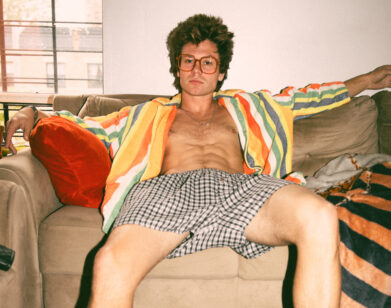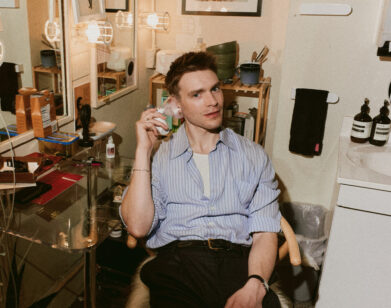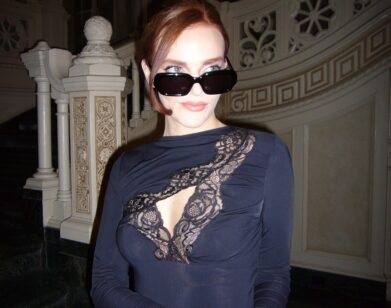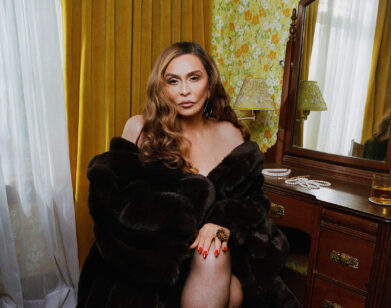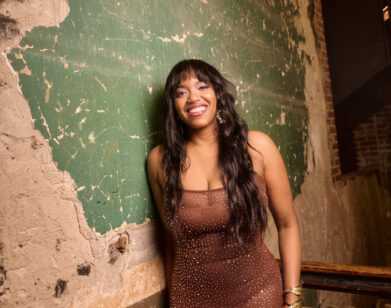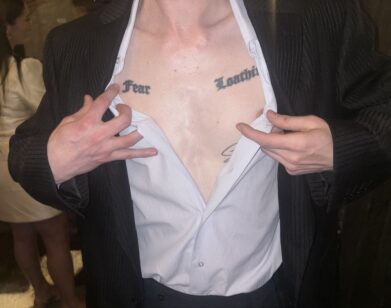IN STUDIO
The Girls Of SC103 Take Us Behind The Scenes Of Their Solo Show At Theta
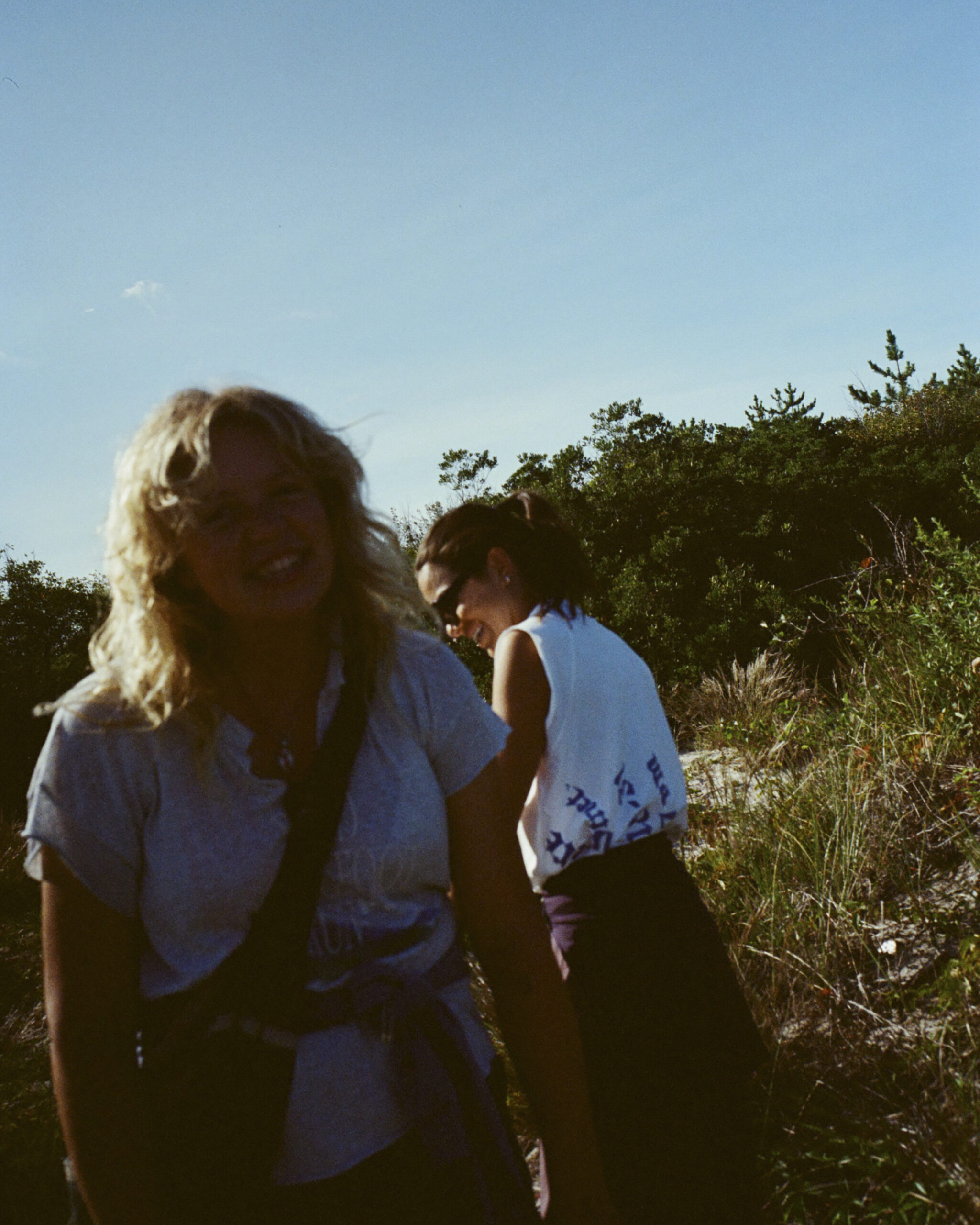
Claire McKinney and Sophie Gascon-Andes, photographed by Matt Callahan.
A couple of weeks ago, just before an unbearable NYC heatwave finally broke at the hands of a torrential downpour, a hoard of art school graduates crawled over each other on Tribeca’s cobbled streets to peek inside the show at Theta: a solo presentation from the minds behind the beloved indie fashion brand (and the unavoidable Links bag) SC103. Founded in 2019 by Sophie Andes-Gascon and Claire McKinney in their shared Brooklyn apartment, their garments are constructed from a hodgepodge of different craft and textile practices including embroidery, dying, screen blocking, and screen printing. Their solo show, Chimera, features textile based studies or “palettes” that the pair assembled in preparation for their next runway presentation, ceramic dioramas that memorialize the spaces that the two have collaborated in, and a physical catalogue that chronicles their work over the years. Shortly after the opening, I joined the girls on a Zoom call to find out how they went from art school roommates to collaborators (spoiler: they don’t fight), turning their rough drafts into a gallery show, and what it’s like to see their creations worn in the wild.
———
EMILY SANDSTROM: For some reason, the first thing I have in front of me is a screenshot of that article from The Cut that’s like, “What your designer bag says about you.” Have you guys seen it?
SOPHIE ANDES GASCON: I don’t think so.
CLAIRE MCKINNEY: I don’t think we have.
SANDSTROM: Well, the story includes your bag and it says, “If you graduated from a liberal-arts college between 2012 and 2019… And now work at a gallery in Chelsea, just until your small-batch ceramic mugs take off. You are good at roasting radicchio. Then you might carry the SC103 Links Bag.”
MCKINNEY: That’s so funny.
SANDSTROM: It made me laugh.
ANDES GASCON: I do love radicchio, so that checks out.

Scan from SC103 September 9, 2022, 9PM, New York, 2024. Edition of 168. Paperback with jacket, 146 pages. 9 1⁄2 x 6 1⁄2 in.
MCKINNEY: And I guess we both went to Pratt, so I suppose a lot of people in our world are probably art school or liberal arts grads.
SANDSTROM: Yeah. So, you’re not beating the allegations.
MCKINNEY: Not entirely.
ANDES GASCON: But it’s fun to see all the different interpretations, because we know such a wide range of people that enjoy wearing the bags, and I’m sure my dad would get a kick out of being this “downtown girl.” I’ll have to find that and send it to him.
SANDSTROM: So your dad’s wearing the bag?
ANDES GASCON: Dad’s wearing the bag, boyfriend’s wear the bag. A lot of our friends wear the bags. I think the people that stop us the most and ask about the bags are usually women in their 50s to late 60s that connect to the material or just want to understand how it’s made.
SANDSTROM: That’s cool. I wanted to talk about your show at Theta that just opened. Some of the pieces resemble your garments, and I was reading them as studies, or like world building devices. I was wondering if you could broadly explain your approach to the show and putting together this body of work for a gallery environment?
MCKINNEY: I love that word, study, because we’ve used similar ones. We’ve used drafts, sketches, trials and gestures, I think. A lot of the textile pieces on the wall that resemble garments are very much palettes for exploring portions of canvases that are works in progress, almost. We’re at the time of year where we’re building the initial ideas for our collection that’ll come out in September, and we were able to really play much more through building the body of work for the Theta show. It was just a lot of fun to be able to have this opportunity to build drafts that then we continued to build upon for the show.

Installation view of Chimera. Courtesy of Theta, New York.
SANDSTROM: I was just thinking about the few pieces that have fabric as the base, but the shapes don’t really resemble garments. There was one that almost looked like wings. What was the idea behind those?
ANDES GASCON: All of the pieces that resemble garments kind of started one way and have evolved to be the way that they are for the show. And should we receive them back in our possession, I think they’ll stay as part of our world and our collection, and we’ll end up building on top of them. That butterfly thing started with this exploration of armor, and–what were the baseball things that we were looking at, Claire?
MCKINNEY: Oh, catchers guards and umpire vests.
ANDES GASCON: Right, so it started by looking at the lines of these catchers mitts, and then creating these layers of fabric and stitching. And as it lived in the studio, it just got more and more embellished. These wings came into the world at the studio, and got added in as sort of this nod to a parade or something otherworldly.
SANDSTROM: Yeah, there is this kind of a celebratory theme throughout.
MCKINNEY: Yeah, I think those places, parades, festivals, anything that involves movement and costume, celebratory events are things that we always come back to, and are ways to think about our events and runway shows. Also they’re garments that feel like they’ve been added to in this really intentional and meaningful way, of beads representing colors that are associated with identity, sort of bringing value to textures and materials. We’re looking a lot at flags, not flags in a national sense, but more of a celebration of personal identity and communication through words and color. I’m rambling now, but yeah, it’s more like folklore or a folk festival direction to motif making through textile.
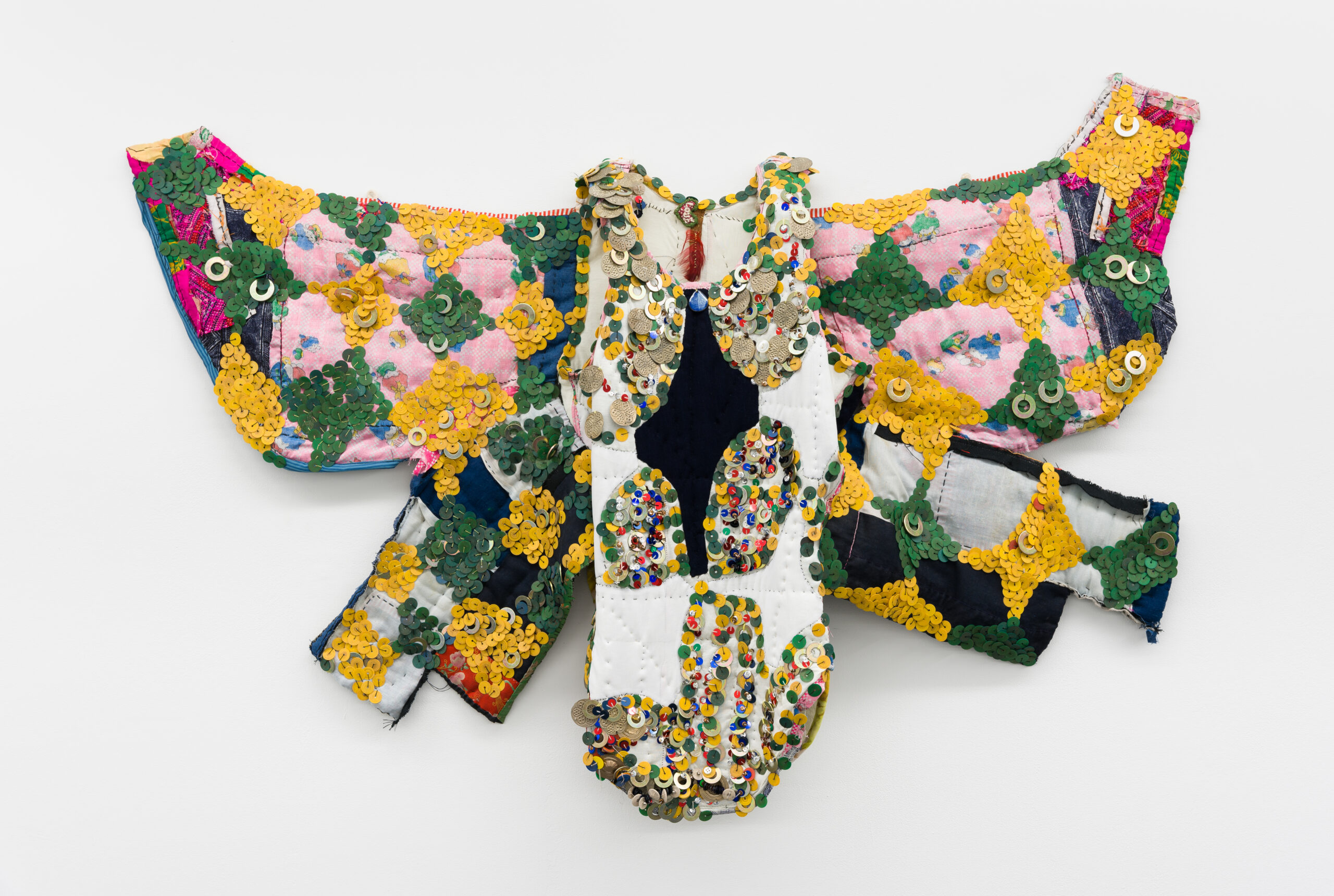
Sophie Andes-Gascon for SC103. Lyric 22 (Nectar), 2024. Cotton and silk textiles; vinyl sequins; washers; assorted metal disc. 31 x 44 1⁄2 x 3 in. Courtesy of Theta, New York.
SANDSTROM: Yeah, I see that. Almost slightly Renaissance themed. I’m thinking about some of the fonts or printmaking included.
ANDES GASCON: Exactly. I like even looking at all the pieces, like you’re saying, Claire, as these flags that hold a lot of our shared identity.
SANDSTROM: Totally. I guess this is a good segue, because I was really curious about your references, and where you’re sourcing that inspiration from? What do your desktops or Tumblr feeds look like?
ANDES GASCON: We really don’t have many reference boards, if any, I would say, Claire?
MCKINNEY: Yeah.
ANDES GASCON: I think the way that the two of us search for inspiration is very tied to our backgrounds and our experiences growing up. Any kind of tangible references that we might have usually come from our own small experiments, and we will typically just text those back and forth to each other. And that kind of serves as a mood board, because to be able to go back and search through images. It’s almost like it creates this small seed, and then things will manifest from there.
MCKINNEY: Yeah, I also feel like we draw more references and inspiration just from natural beauty or like rock patterns, or trees. Just things that really, not to get too cheesy, but works of art in themselves. I think we both have this sort of interest in that nose diving into a really small element of something you experience, whether it’s in the city or in nature, as opposed to heavy research or reference building in the gallery art world or something like that.
ANDES GASCON: And most days we are in the studio, because we have a business to run and a practice to keep. So, these moments that we get to be away from the city are when we’re recharging and getting re-inspired. And when we’re in our studios, we sort of transport ourselves back to those moments.

Studio shot, courtesy of Claire McKinney and Sophie Andes Gascon.
SANDSTROM: Yeah, that makes a lot of sense. I read that you guys were roommates for many years but you weren’t necessarily friends, and then you started working together. And it seems like you guys have such a beautiful relationship, but like, does it ever get weird?
MCKINNEY: Pretty much never. I mean, we became friends in college and then moved in together, but we weren’t like best friends at that point.
ANDES GASCON: That was actually part of the draw of moving in together like, “Oh, it won’t be weird because we’re not the best of friends–”
SANDSTROM: And then instead you guys just built this culty brand, and now you’re stuck together forever.
MCKINNEY: [Laughs] Yeah exactly. I also think we both worked for other people for, was it seven years or so?
ANDES GASCON: Mm-hmm.
MCKINNEY: For quite a long time. So, coming home after working all day and having this little secret tree fort of idea exchange and making, I mean, we would just rush home and make shit all night. That was a really special time to just bounce ideas off each other and–
ANDES GASCON: With nothing at stake at that point, which was the best part.
MCKINNEY: Yeah. But we never fight. And we still live together.
SANDSTROM: I mean, if you guys did fight I would say there’s a good reality TV show waiting to happen. Well, speaking of that sort of joint identity and working together, I read that you guys create separately, because I know you sort of occupy different parts of the process, and then you sort of present it to each other. Is that right? Have you guys ever presented something to each other and been like, “What the fuck?”
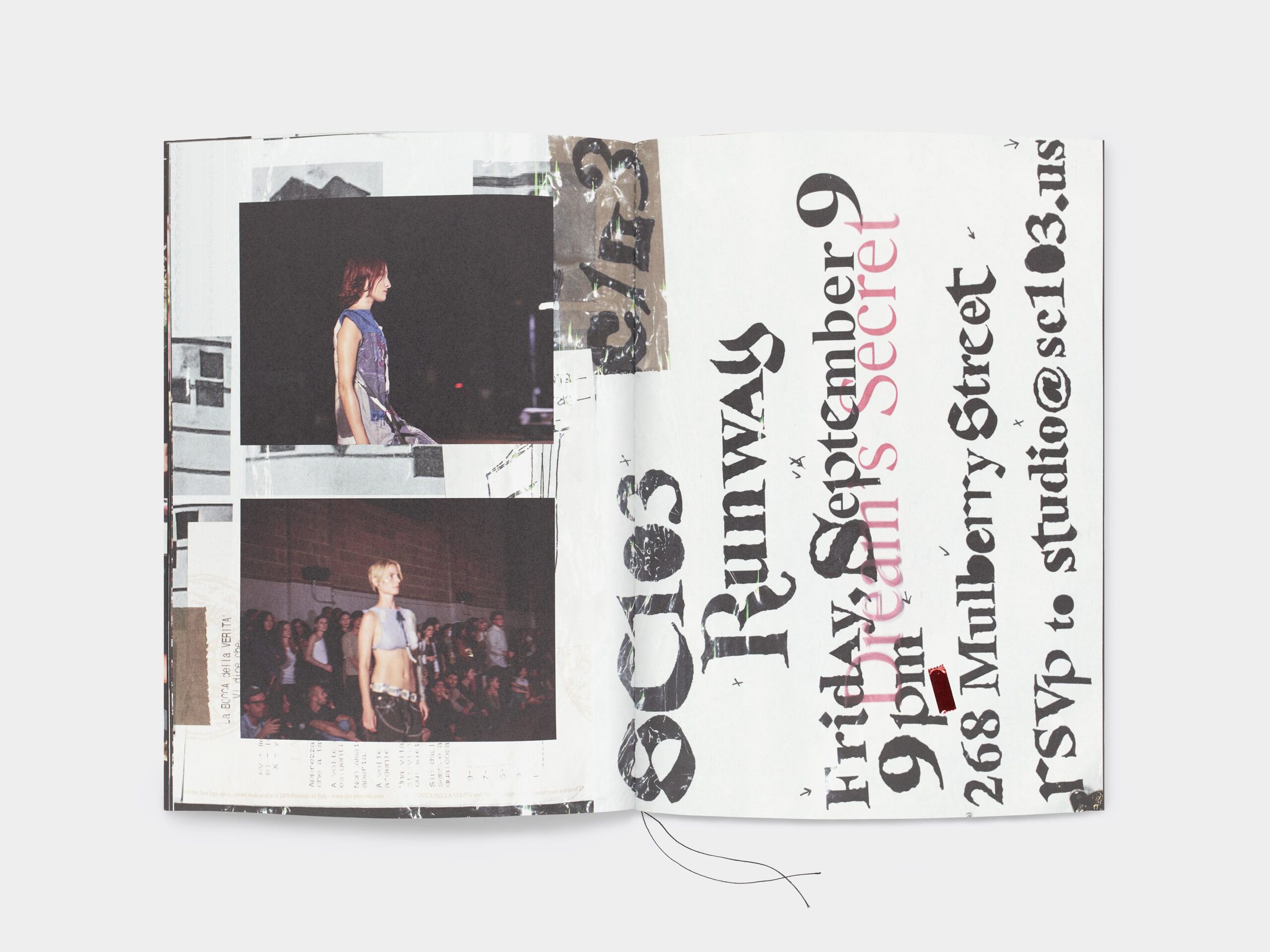
Scan from SC103 September 9, 2022, 9PM, New York, 2024. Edition of 168. Paperback with jacket, 146 pages. 9 1⁄2 x 6 1⁄2 in.
ANDES GASCON: I mean, I think part of the reason that this works for us too is that we’re quite different in the way that we–
MCKINNEY: Approach an idea.
ANDES GASCON: Yeah, and our sensibilities. But what we do share obviously is just a deep respect for each other and trust. There’s a lot of the times when we are presenting things to each other, and it’s just an exercise in partnership. It’s like you’re trying to give someone else the confidence to build upon something that you know is going to be great. We’re each other’s biggest hype people. The things that you would present to someone that might not work, that’ll end up not working. And you don’t need someone else to tell you, “This isn’t working.” The world will show you that. So, it’s more about just building someone up and making each other stronger. Don’t you think? Am I saying that right, Claire?
MCKINNEY: For sure, that’s how I would have said it too. I think what’s so valuable and just exciting about this all is being able to see how someone else would even approach a technique or a color or a texture. It’s just completely eye-opening, “Wow, I would have never thought to take it that direction. This is so exciting.”
SANDSTROM: I like that answer a lot, because everything you guys make really does look like the result of an endless conversation. You know what I mean?
MCKINNEY: Yeah. Between the two of us and how differently we think about making and the visual world, there’s such a huge, wide net of things that fascinate us. And so, sometimes funny things happen from that, but we both love to laugh and turn things upside down and not get too precious about it.

Installation view of Chimera. Courtesy of Theta, New York.
SANDSTROM: Also, the name of the show, Chimera. Am I saying it right? I looked up that word because I didn’t know it, and I got a result back that said “Any grotesque monster having disparate parts,” which I obviously love.
MCKINNEY: Yeah. That word came to us from the roots of the monster being this multi-hybrid female animal that has different elements of different animals, breathes fire, and has this really kind of disruptive and interesting presence. And then also the idea of the word just meaning “coming from multiple places” and being this sort of puzzle that’s a little hard to put your finger on. I think it makes sense with the way we are approaching this show where it’s these ideas that are maybe not fully… So many of the garments are sort of flattened and unwearable. The shoes are just single shoes, these things that are halfway in one direction and halfway in another felt interesting to us. It sort of connects back to Greek mythology and the lettering and my fascination with typography. And it was just a beautiful and fun word to draw, too. Yeah, we sometimes thought of our work as coming from a world that we’ve maybe never been to or may only exist in the imagination, so this word seemed to fit in that as well.
SANDSTROM: Oh wait also, I wanted to talk about the ceramic rooms. I loved them and Jordan was telling me that they’re a reflection of the spaces that you guys have collaborated in.
ANDES GASCON: Yeah. I started making those when we were about to relocate studios. There’s one little white one, and that was the studio that we had downtown, and it was kind of modeled after how we would set it up during our studio sales that we would host. I think it was as a way to capture this memory of a place that we really cherished, into these little ceramic dioramas. I don’t know, I think as much as we transport ourselves within the spaces that we work in, it’s interesting to think about how these boxes that we work within house all of these abundant things that we get to dream up.
MCKINNEY: Yeah. To me, the dioramas are part commemoration and hold that, but also, I mean, I’m a huge Antiques Roadshow enthusiast, and sometimes someone will bring in a miniature stove or something that was a salesman sample, and it’s like these little worlds that feel like cataloged spaces. So, I sort of like that also.
ANDES GASCON: We also hold places dear to our heart. I think that’s what I’m trying to say too, Claire. These places will forever be cemented in our minds, and I’m so grateful because it allowed us to build other little worlds.

Sophie Andes-Gascon for SC103. Lyric 12, 2024. Ceramic stoneware 11 x 10 x 7 1⁄2 in. Courtesy of Theta, New York.

Sophie Andes-Gascon for SC103. Lyric 08 (SC Store), 2024 Ceramic stoneware. 6 x 9 x 7 in.
SANDSTROM: Cool. World in a world. I was also thinking about the Link bags, and how originally they were a way for you to use up leather scraps, right? I’m wondering, with them becoming this sort of culty object and thinking about you guys scaling up or transferring into a commercial context, does it still maintain that organic feeling for you? Or has it maybe lost that essence in some ways?
MCKINNEY: We still handle the bag making from start to finish in our studio, from identifying leathers to use to working with a dye cutter, to making all the bags in our studio, cleaning them, labeling them, tagging them, packing them up and shipping them out. So, the making of them, even at the larger commercial scale that they are now, still happens all in our space. And I think what’s brought a lot of excitement and joy has been teaching people how to make the bags and that has taught us the process of streamlining the making of the bags. That’s been not only really helpful for the business, but also a creative experience in itself too.
ANDES GASCON: Yeah. We kind of have little control of what happens once the bags leave our studio and how they’re perceived or who gets to wear them and what gets written about them. But like Claire said, it’s still very much something that’s really true to what the brand stands for.
SANDSTROM: Yeah. I mean, is it fucking weird to have made a bag that everyone is wearing? I imagine it’s probably strange.
MCKINNEY: It definitely was surprising to see the first people we didn’t personally know wearing a bag. The first couple years or a year at least, it’s, “Oh, I sold that bag to that person. That checks out.” But then starting to see them in other places in the world and on other people is really, really exciting and humbling and just cool.
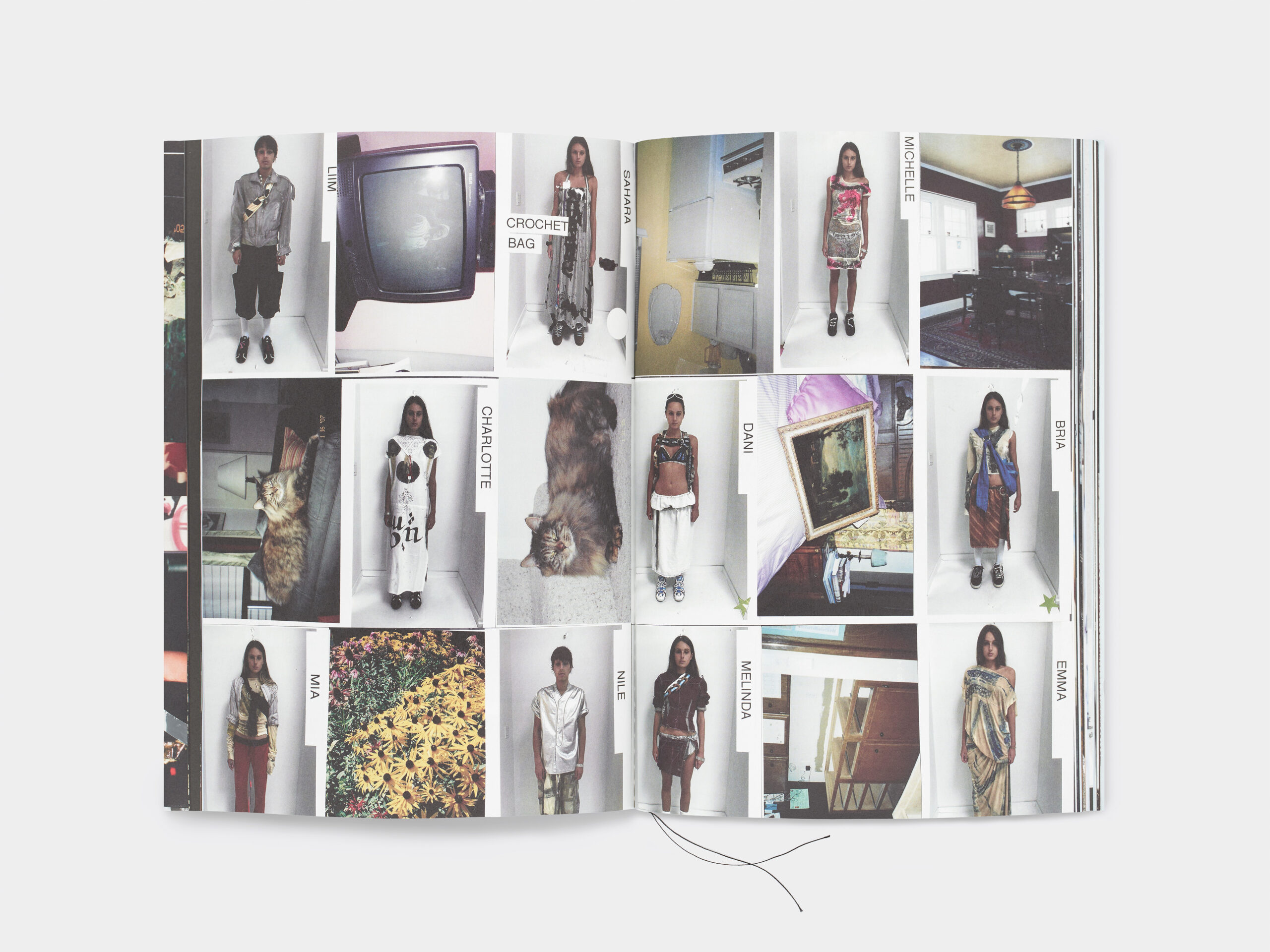
Scan from SC103 September 9, 2022, 9PM, New York, 2024. Edition of 168. Paperback with jacket, 146 pages. 9 1⁄2 x 6 1⁄2 in.
SANDSTROM: Do you guys feel responsible for hundreds of missing lipsticks that are probably scattered around the city?
MCKINNEY: [Laughs] I think there’s something funny about the fact that the bag has… Or, I’ve never had anything fall out of the bag, which must mean I don’t wear enough makeup for it to fall out. I don’t know.
ANDES GASCON: I like that among so many talking points that the bag creates for people that that’s one of the icebreakers. It does make me happy that there is conversation around this controversial item that either people love or just will never understand. But yeah, sorry girls.
MCKINNEY: I once had an experience where I was in a dressing room at one of our stockists here in New York trying a swimsuit on, and what sounded like a sixty-year-old guy was looking at our bag from outside the dressing room was like, “Who would ever buy this bag? It’s full of holes.”

